On Mechanical Properties of Welded Joint in Novel High-Mn Cryogenic Steel in Terms of Microstructural Evolution and Solute Segregation
Abstract
1. Introduction
2. Experimental Procedure
2.1. Materials
2.2. Welding Procedure
2.3. Mechanical Property Tests
2.4. Microstructure Characterization
3. Results
3.1. Microstructure Characteristics
3.2. Tensile Properties at Room and Cryogenic Temperatures (−196 °C)
3.3. Vickers Macrohardness Distribution
3.4. Cryogenic Charpy Impact Toughness
3.5. Deformation Behavior under Cryogenic-Temperature Impact Loading
4. Discussion
5. Conclusions
- (1)
- At room temperature, the WJ has the yield strength, tensile strength and tensile elongation of 444 MPa, 768 MPa and 27.7%, respectively. The yield strength of WJ increases by 21 MPa with respect to the BM, but the tensile strength and elongation decrease obviously. At −196 °C, the yield strength of the BM and WJ is nearly twice as much as that at room temperature. The yield strength of WJ decreases slightly with respect to the BM, but the tensile strength and elongation decrease greatly. Regardless of testing temperatures, the WJ was broken at WM due to its poorer strain hardening capacity with respect to the BM.
- (2)
- The cryogenic impact toughness at the WM and FL locations is the worst, and both Charpy impact absorbed energies are about 55 J. The fractographs of impact fractures in HAZ all have typical ductile dimple fracture features. However, the cryogenic impact toughness of CGHAZ is decreased, and the analyses shows that the twinning behavior in CGHAZ is inhibited with respect to the BM.
- (3)
- There is severe C-Mn-Si alloying segregation and depletion in the CGHAZ. The higher in the C-Mn-Si segregation band of CGHAZ indicates difficulty twinning, which leads to a deterioration in plastic deformation capacity at cryogenic temperature. Additionally, the inhomogeneous microstructure of CGHAZ would promote the localized plastic deformation, readily leading to the formation of micro voids. Additionally, the higher defect density in hardened austenite also retards the migration of dislocations, finally deteriorating the cryogenic impact toughness of the CGHAZ.
Author Contributions
Funding
Conflicts of Interest
References
- Choi, J.K.; Lee, S.-G.; Park, Y.-H.; Han, I.-W. High Manganese Austenitic Steel for Cryogenic Applications. In Proceedings of the Twenty-Second International Offshore and Polar Engineering Conference, Rhodes, Greece, 17–22 June 2012; pp. 29–35. [Google Scholar]
- Kumar, S.; Kwon, H.T.; Choi, K.H.; Cho, J.H.; Lim, W.; Moon, I. Current status and future projections of LNG demand and supplies: A global prospective. Energy Policy 2011, 39, 4097–4104. [Google Scholar] [CrossRef]
- Ahsan, Q.; Haseeb, A.S.M.A.; Syahriah Binti Hussein, N.I.; Chang, S.Y. 6.08–9% Nickel Steels and Their Welding Behavior. Comp. Mater. Process. 2014, 6, 135–149. [Google Scholar]
- Watanabe, M.; Tanaka, J.; Watanabe, I. Gas Metal Arc Welding of 9% Nickel Steel Using Ferritic Filler Metal Used for Building LNG Transport Tanker. J. Soc. Nav. Archit. Jpn. 2009, 132, 447–462. [Google Scholar] [CrossRef][Green Version]
- Park, M.; Kang, M.S.; Park, G.W.; Choi, E.Y.; Kim, H.C.; Moon, H.S.; Jeon, J.B.; Kim, H.; Se-Hun Kwon, S.H.; Kim, B.J. The Effects of Recrystallization on Strength and Impact Toughness of Cold-Worked High-Mn Austenitic Steels. Metals 2019, 9, 948. [Google Scholar] [CrossRef]
- Luo, Q.; Wang, H.H.; Li, G.Q.; Sun, C.; Li, D.H.; Wan, X.L. On mechanical properties of novel high-Mn cryogenic steel in terms of SFE and microstructural evolution. Mater. Sci. Eng. A 2018, 753, 91–98. [Google Scholar] [CrossRef]
- Wang, X.J.; Sun, X.J.; Song, C.; Chen, H.; Tong, S.; Han, W.; Pan, F. Grain Size-Dependent Mechanical Properties of a High-Manganese Austenitic Steel. Acta Metall. Sin. 2018, 32, 746–754. [Google Scholar] [CrossRef]
- Dong, Y.C.; Sun, Z.L.; Xia, H.; Feng, J.H.; Du, J.J.; Fang, W.; Liu, B.X.; Wang, G.K.; Li, L.; Zhang, X.; et al. The Influence of Warm Rolling Reduction on Microstructure Evolution, Tensile Deformation Mechanism and Mechanical Properties of an Fe-30Mn-4Si-2Al TRIP/TWIP Steel. Metals 2018, 8, 742. [Google Scholar] [CrossRef]
- Park, G.; Kim, B.; Kang, Y.; Kang, H.; Lee, C. Characterization of bond line discontinuities in a high-Mn TWIP steel pipe welded by HF-ERW. Mater. Charact. 2016, 118, 14–21. [Google Scholar] [CrossRef]
- García-García, V.; Mejía, I.; Reyes-Calderón, F. Experimental and FEM study of Ti-containing TWIP steel weldability. J. Mater. Process. Tech. 2018, 261, 107–122. [Google Scholar] [CrossRef]
- Roncery, L.M.; Weber, S.; Theisen, W. Welding of twinning-induced plasticity steels. Scr. Mater. 2012, 66, 997–1001. [Google Scholar] [CrossRef]
- Dai, K.; He, P.; Zhu, L.; Zhang, F.J.; Chen, F.Y.; Zhai, X.; Xiao, W.K. Effect of solution treatment on microstructure and cryogenic toughness of 316LN austenite stainless steel weld metal welded by NG-MAG arc welding. Fusion Eng. Des. 2017, 125, 178–188. [Google Scholar] [CrossRef]
- Saeidi, K.; Gao, X.; Zhong, Y.; Shen, Z.J. Hardened austenite steel with columnar sub-grain structure formed by laser melting. Mater. Sci. Eng. A 2015, 625, 221–229. [Google Scholar] [CrossRef]
- Xiao, W.K.; Zhu, L.; Zhang, F.J.; Dai, K.S.; Zai, X.; Yang, X.; Chen, B.J. Effect of heat input on cryogenic toughness of 316LN austenitic stainless steel NG-MAG welding joints with large thickness. Mater. Des. 2015, 86, 160–167. [Google Scholar]
- Haupt, M.; Müller, M.; Haase, C.; Sevsek, S.; Brasche, F.; Schwedt, A.; Hirt, G. The Influence of Warm Rolling on Microstructure and Deformation Behavior of High Manganese Steels. Metals 2019, 9, 979. [Google Scholar] [CrossRef]
- Razmpoosh, M.H.; Shamanian, M.; Esmailzadeh, M. The microstructural evolution and mechanical properties of resistance spot welded Fe-31Mn-3Al-3Si TWIP steel. Mater. Des. 2015, 67, 571–576. [Google Scholar] [CrossRef]
- Wang, T.; Zhang, M.; Xiong, W.; Liu, R.D.; Shi, W.; Li, L. Microstructure and tensile properties of the laser welded TWIP steel and the deformation behavior of the fusion zone. Mater. Des. 2015, 83, 103–111. [Google Scholar] [CrossRef]
- Ahmed, M.M.Z.; Ahmed, E.; Hamada, A.S.; Khodir, S.A.; El-Sayed Seleman, M.M.; Wynne, B.P. Microstructure and mechanical properties evolution of friction stir spot welded high-Mn twinning-induced plasticity steel. Mater. Des. 2016, 91, 378–387. [Google Scholar] [CrossRef]
- Yoo, J.; Kim, B.; Park, Y.; Lee, C. Microstructural evolution and solidification cracking susceptibility of Fe–18Mn–0.6C–xAl steel welds. J. Mater. Sci. 2015, 50, 279–286. [Google Scholar] [CrossRef]
- Han, K.; Yoo, J.; Lee, B.; Han, I.; Lee, C. Effect of Ni on the hot ductility and hot cracking susceptibility of high Mn austenitic cast steel. Mater. Sci. Eng. A 2014, 618, 295–304. [Google Scholar] [CrossRef]
- Han, K.; Yoo, J.; Lee, B.; Han, I.; Lee, C. Hot ductility and hot cracking susceptibility of Ti-modified austenitic high Mn steel weld HAZ. Mater. Chem. Phys. 2016, 184, 118–129. [Google Scholar] [CrossRef]
- IGF Code. International Code of Safety for Ship Using Gases or Other Low-Flashpoint Fuels; IMO: London, UK, 2014. [Google Scholar]
- Liessem, A.; Erdelen-Peppler, M. A Critical View on the Significance of HAZ Toughness Testing. In Proceedings of the International Pipeline Conference, Calgary, AB, Canada, 4–8 October 2004. [Google Scholar]
- Xu, X.D.; Liu, P.; Tang, Z.; Hirata, A.; Song, S.X.; Nieh, T.G.; Liaw, P.K.; Liu, C.Y.; Chen, M.W. Transmission electron microscopy characterization of dislocation structure in a face-centered cubic high-entropy alloy Al0.1CoCrFeNi. Acta Mater. 2018, 144, 107–115. [Google Scholar] [CrossRef]
- De Cooman, B.C.; Estrin, Y.; Kim, S.K. Twinning-Induced Plasticity (TWIP) Steels. Acta Mater. 2018, 142, 283–362. [Google Scholar] [CrossRef]
- Jin, J.-E.; Lee, Y.-K. Effects of Al on microstructure and tensile properties of C-bearing high Mn TWIP steel. Acta Mater. 2012, 60, 1680–1688. [Google Scholar] [CrossRef]
- Jin, J.-E.; Lee, Y.-K. Strain hardening behavior of a Fe–18Mn–0.6C–1.5Al TWIP steel. Mater. Sci. Eng. A 2009, 527, 157–161. [Google Scholar] [CrossRef]
- Gutierrez-Urrutia, I.; Zaefferer, S.; Raabe, D. The effect of grain size and grain orientation on deformation twinning in a Fe–22 wt.% Mn–0.6 wt.% C TWIP steel. Mater. Sci. Eng. A 2010, 527, 3552–3560. [Google Scholar] [CrossRef]
- Curtze, S.; Kuokkala, V.T. Dependence of tensile deformation behavior of TWIP steels on stacking fault energy, temperature and strain rate. Acta Mater. 2010, 58, 5129–5141. [Google Scholar] [CrossRef]
- Saha, D.C.; Han, S.; Chin, K.G.; Choi, I.; Park, Y.-D. Weldability Evaluation and Microstructure Analysis of Resistance-Spot-Welded High-Mn Steel in Automotive Application. Steel. Res. 2012, 83, 352–357. [Google Scholar] [CrossRef]
- Mujica, L.; Weber, S.; Thomy, C.; Vollertsen, F. Microstructure and mechanical properties of laser welded austenitic high manganese steels. Sci. Technol. Weld. Join. 2009, 14, 517–522. [Google Scholar] [CrossRef]
- A1106/A1106M–17, Standard Specification for Pressure Vessel Plate, Alloy Steel, Austenitic High Manganese for Cryogenic Application; ASTM Committee: West Conshohocken, PA, USA, 2017.
- Chen, J.; Ren, J.-K.; Liu, Z.-Y.; Wang, G.-D. Interpretation of significant decrease in cryogenic-temperature Charpy impact toughness in a high manganese steel. Mater. Sci. Eng. A 2018, 737, 158–165. [Google Scholar] [CrossRef]
- Chen, J.; Dong, F.-T.; Jiang, H.-L.; Liu, Z.-Y.; Wang, G.-D. Influence of final rolling temperature on microstructure and mechanical properties in a hot-rolled TWIP steel for cryogenic application. Mater. Sci. Eng. A 2018, 724, 330–334. [Google Scholar] [CrossRef]
- Kim, J.; Yuri, E.; De Cooman, B.C. Application of a Dislocation Density-Based Constitutive Model to Al-Alloyed TWIP Steel. Metall. Mater. Trans. A 2013, 44, 4168–4182. [Google Scholar] [CrossRef]
- Luo, Z.C.; Huang, M.X. Revisit the role of deformation twins on the work-hardening behavior of twinning-induced plasticity steels. Scr. Mater. 2018, 142, 28–31. [Google Scholar] [CrossRef]
- Shen, X.J.; Tang, S.; Chen, J.; Liu, Z.Y.; Misra, R.D.K.; Wang, G.D. Grain refinement in surface layers through deformation-induced ferrite transformation in microalloyed steel plate. Mater. Des. 2017, 113, 137–141. [Google Scholar] [CrossRef]
- Taban, E.; Deleu, E.; Dhooge, A.; Kaluc, E. Laser welding of modified 12% Cr stainless steel: Strength, fatigue, toughness, microstructure and corrosion properties. Mater. Des. 2009, 30, 1193–1200. [Google Scholar] [CrossRef]
- Wang, X.J.; Sun, X.J.; Song, C.; Chen, H.; Tong, S.; Han, W.; Pan, F. Evolution of microstructures and mechanical properties during solution treatment of a Ti-V-Mo-containing high-manganese cryogenic steel. Mater. Charact. 2018, 135, 287–294. [Google Scholar] [CrossRef]
- Mujica, L. Development of High-Strength Corrosion-Resistant Austenitic TWIP Steels with C+N. Ph.D. Thesis, Ruhr-Universität Bochum, Bochum, Germany, 2010. [Google Scholar]
- Bouaziz, O.; Zurob, H.; Chehab, B.; Embury, J.D.; Allian, S.; Huang, M. Effect of chemical composition on work hardening of Fe–Mn–C TWIP steels. Mater. Sci. Technol. 2011, 27, 707–709. [Google Scholar] [CrossRef]
- Jeong, K.; Jin, J.-E.; Jung, Y.-S.; Kang, S.; Lee, Y.-K. The effects of Si on the mechanical twinning and strain hardening of Fe–18Mn–0.6C twinning-induced plasticity steel. Acta Mater. 2013, 61, 3399–3410. [Google Scholar] [CrossRef]
- Herbig, M.; Kuzmina, M.; Haase, C.; Marceau, R.K.W.; Gutierrez-Urrutia, I.; Haley, D.; Molodov, D.A.; Choi, P.; Raabe, D. Grain boundary segregation in Fe–Mn–C twinning-induced plasticity steels studied by correlative electron backscatter diffraction and atom probe tomography. Acta Mater. 2015, 83, 37–47. [Google Scholar] [CrossRef]
- Hong, S.; Shin, S.Y.; Kim, H.S.; Lee, S.; Kim, S.-K.; Chin, K.-G.; Kim, N.J. Effects of aluminum addition on tensile and cup forming properties of three twinning induced plasticity steels. Metall. Mater. Trans. A 2012, 43, 1870–1883. [Google Scholar] [CrossRef]
- Byun, T.S.; Hashmoto, N.; Farrell, K. Temperature dependence of strain hardening and plastic instability behaviors in austenitic stainless steels. Acta Mater. 2004, 52, 3889–3899. [Google Scholar] [CrossRef]
- Bouaziz, O.; Allain, S.; Scott, C. Effect of grain and twin boundaries on the hardening mechanisms of twinning-induced plasticity steels. Scr. Mater. 2008, 58, 484–487. [Google Scholar] [CrossRef]
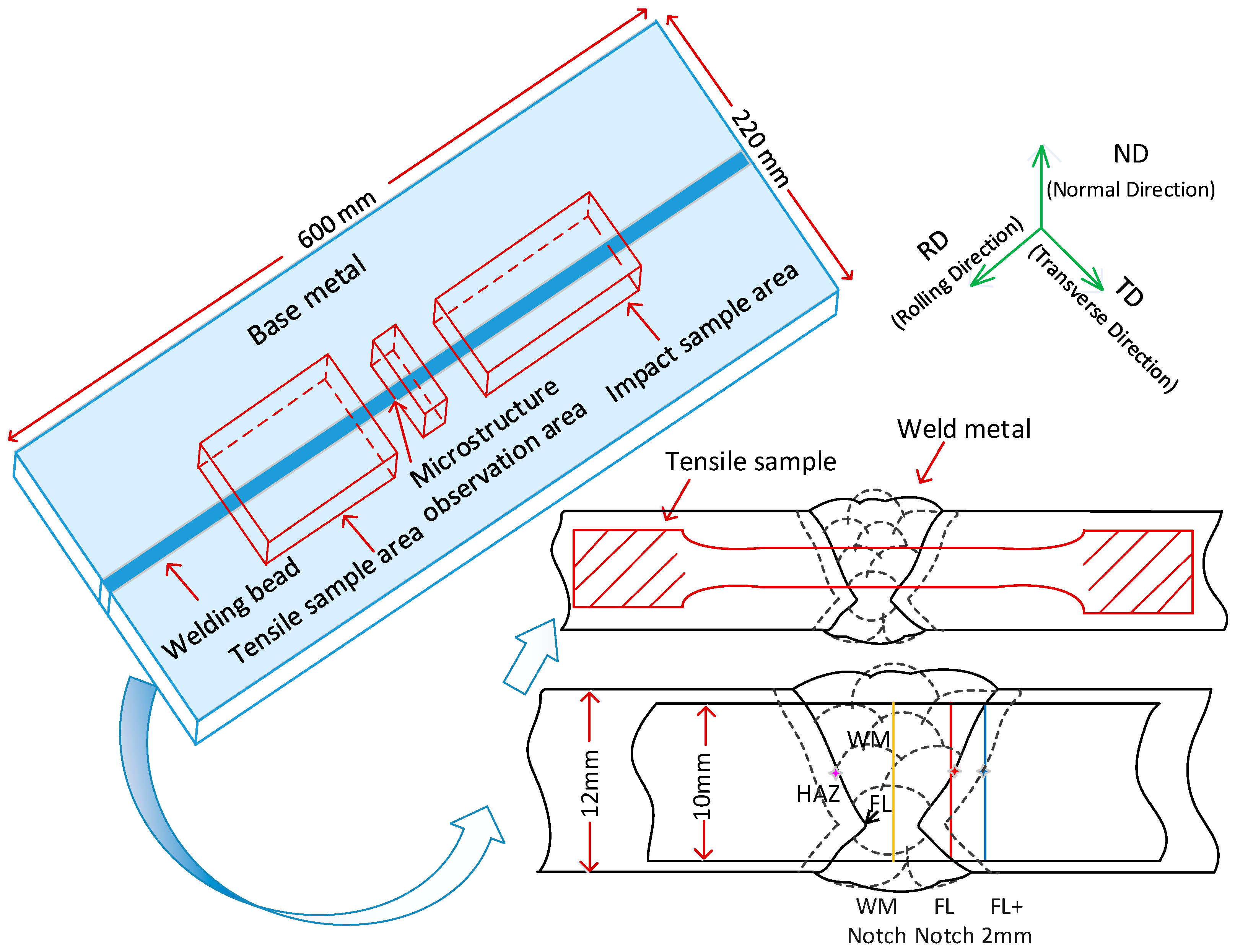



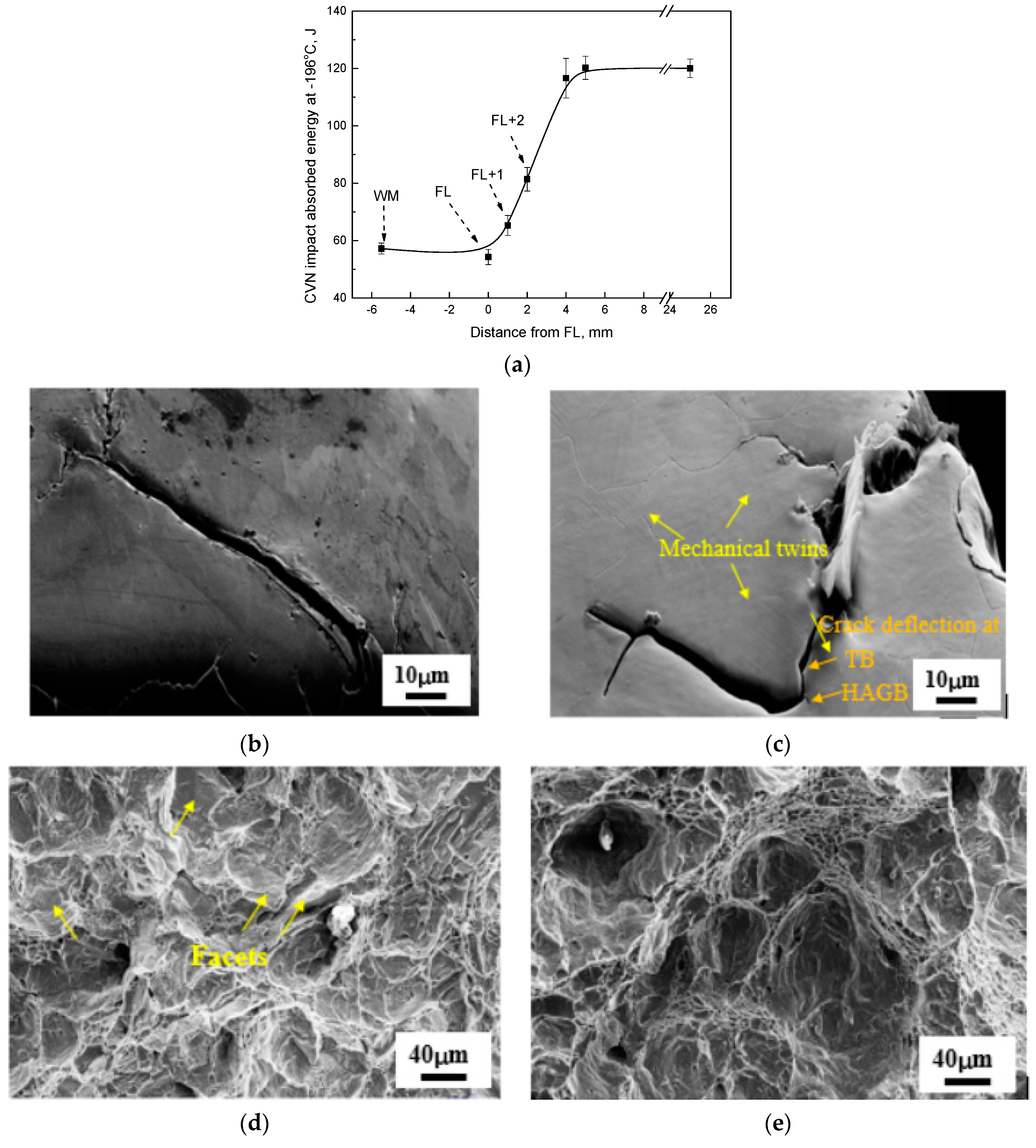
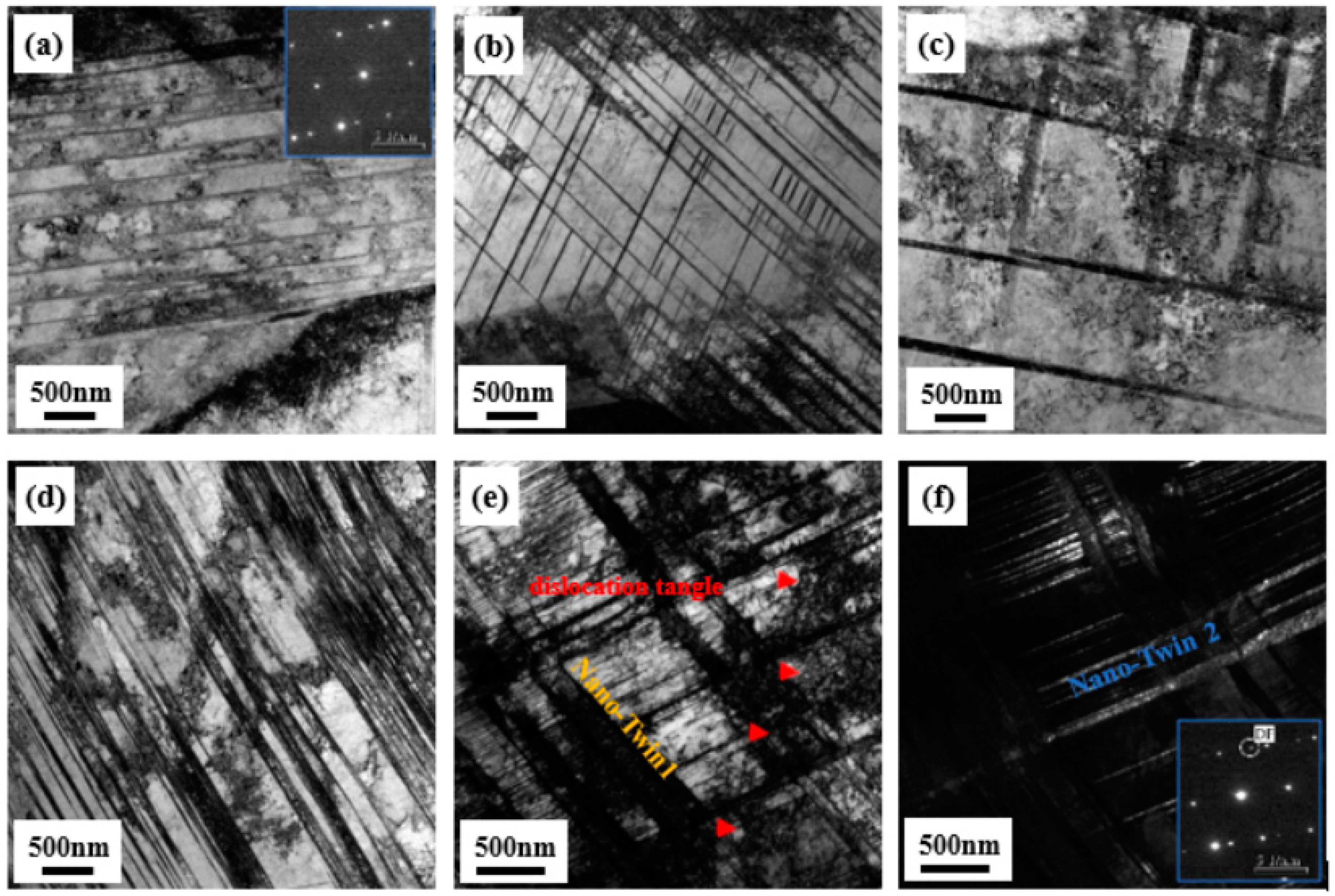
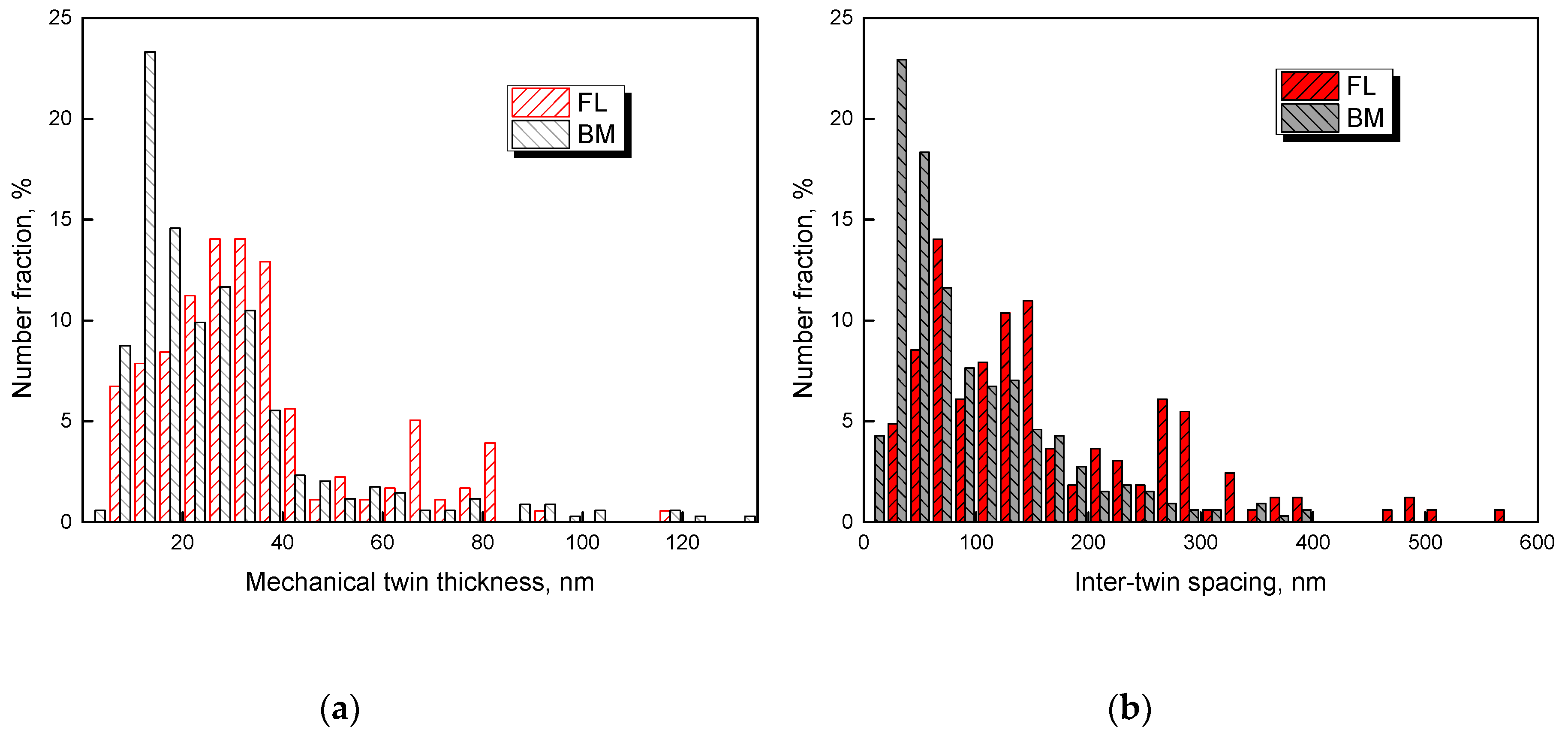
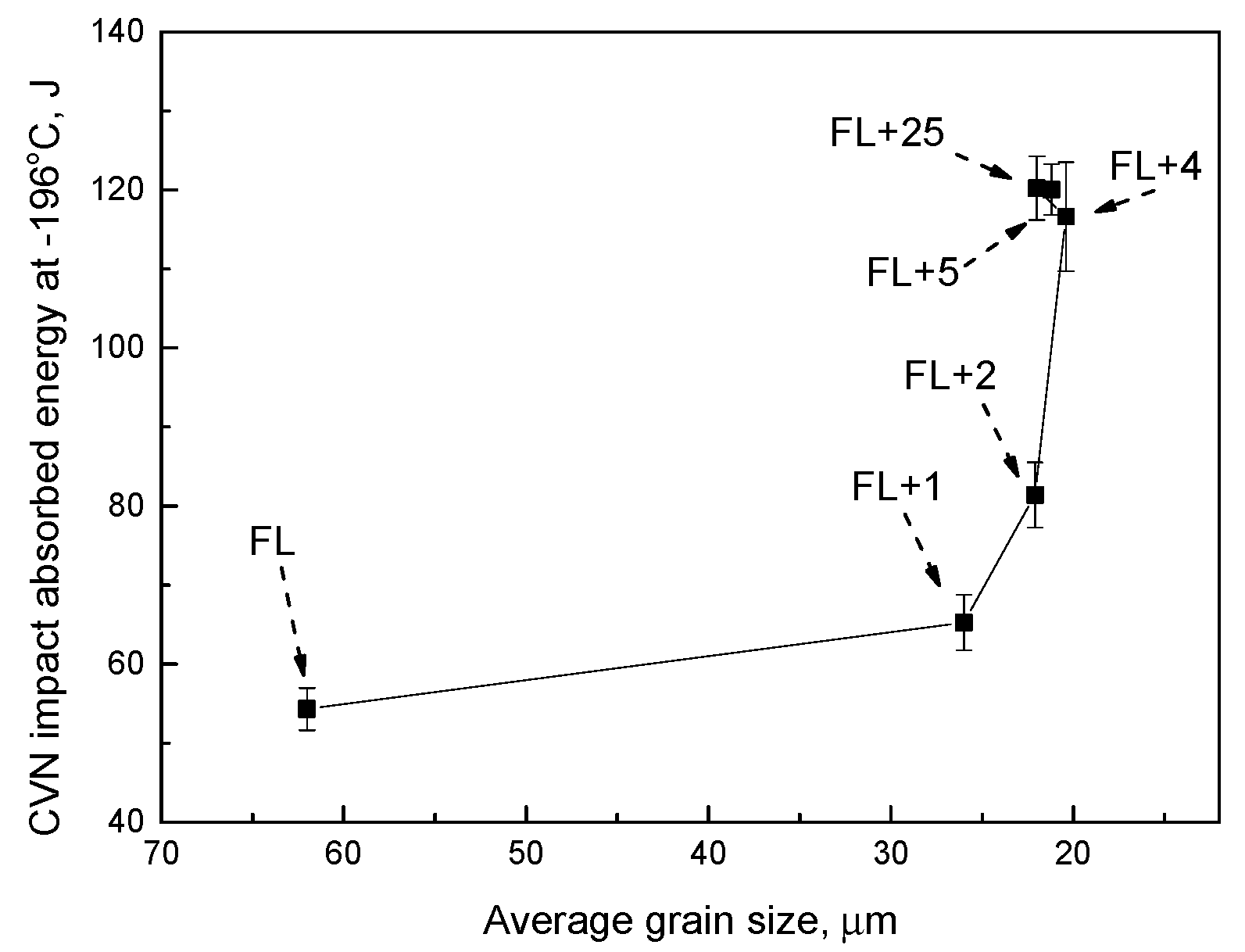
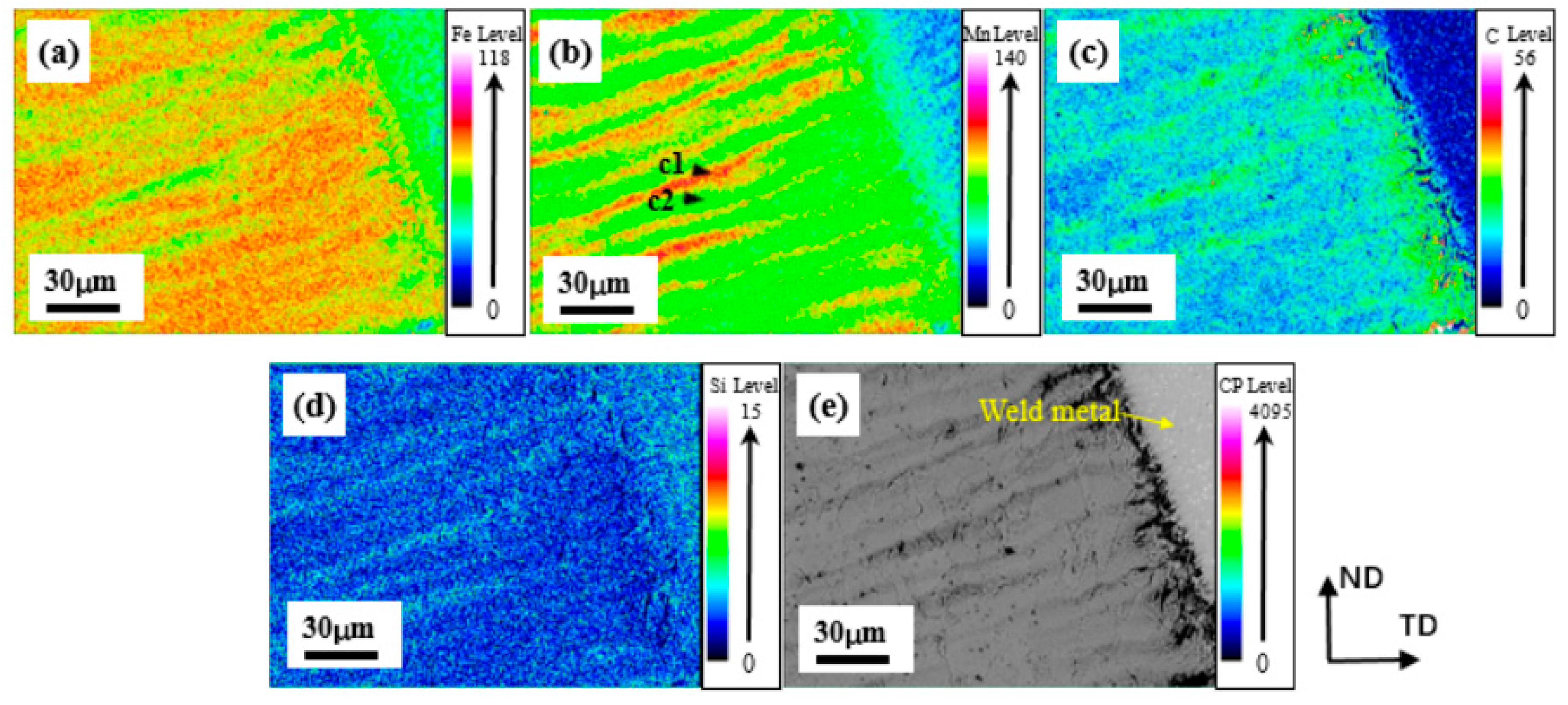

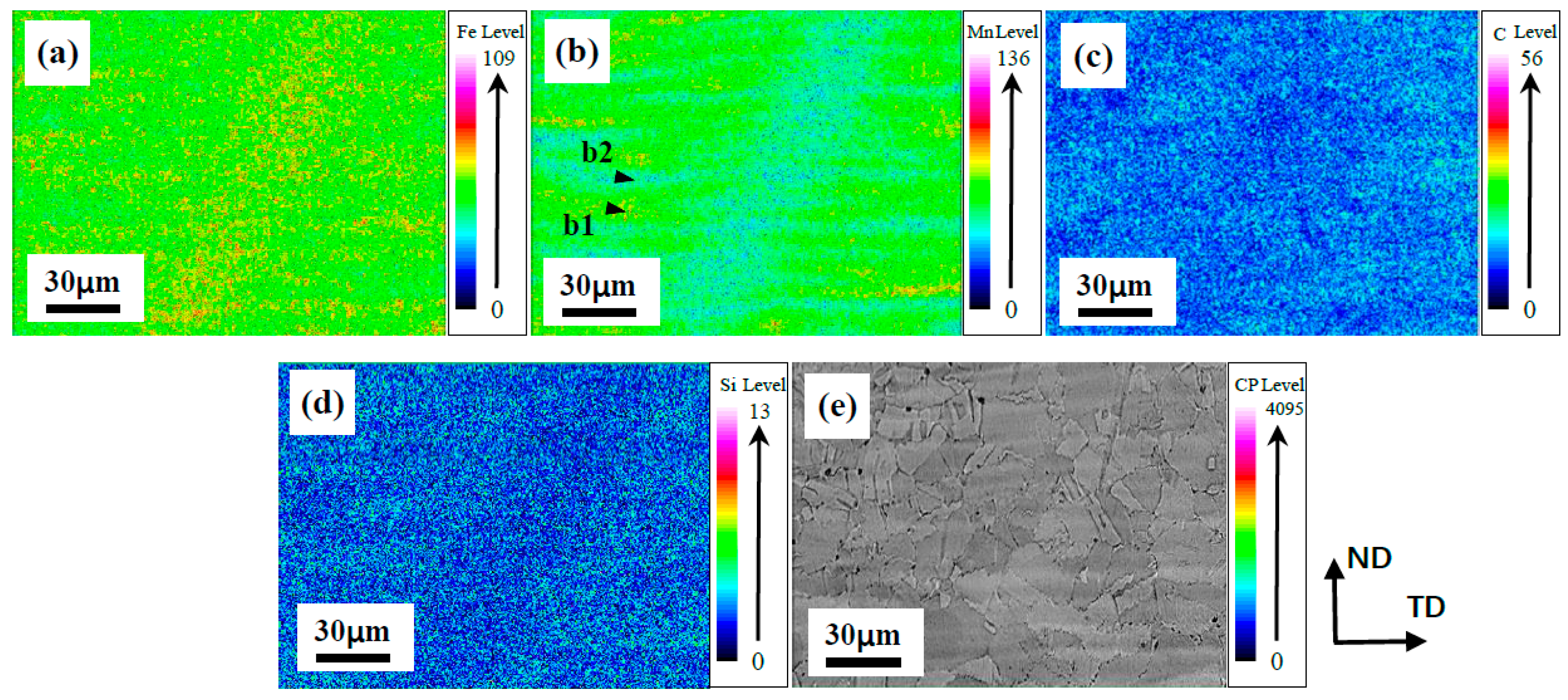
| Alloy | C | Mn | Si | Al | V | Cr | Mo | P | S | Fe | Ni |
|---|---|---|---|---|---|---|---|---|---|---|---|
| Base material | 0.57 | 24.4 | 0.48 | 1.92 | 0.31 | – | – | 0.004 | 0.005 | Bal. | – |
| Filler metal | 0.01 | 3.7 | 0.07 | – | – | 13.27 | 6.16 | 0.001 | 0.001 | – | Bal. |
| Alloy | Yield Strength, MPa | Tensile Strength, MPa | Charpy V-notch Impact Energy, J (−196 °C) |
|---|---|---|---|
| Nickel-based welding core | 445 | 700 | 100 |
| Test Temperature | Steel | Yield Strength, MPa | Tensile Strength, MPa | Tensile Elongation, % |
|---|---|---|---|---|
| 25 °C | BM | 423 ± 16 | 853 ± 14 | 64.2 ± 1.4 |
| WJ | 444 ± 5 | 768 ± 8 | 27.7 ± 2.1 | |
| −196 °C | BM | 871 ± 3 | 1447 ± 2 | 80.1 ± 1.8 |
| WJ | 804 ± 15 | 1027 ± 6 | 11.2 ± 1.3 |
| Locations | C, wt.% | Mn, wt.% | Si, wt.% | Al, wt.% | (25 °C)mJ/m2 | (−196 °C), MPa |
|---|---|---|---|---|---|---|
| c1 | 0.81 | 28.8 | 0.50 | 1.56 | 54.2 | 434.1 |
| c2 | 0.44 | 22.6 | 0.34 | 1.63 | 35.0 | 280.5 |
| b1 | 0.61 | 26.2 | 0.50 | 1.53 | 45.2 | 371.1 |
| b2 | 0.53 | 23.8 | 0.44 | 1.54 | 39.5 | 317.4 |
© 2020 by the authors. Licensee MDPI, Basel, Switzerland. This article is an open access article distributed under the terms and conditions of the Creative Commons Attribution (CC BY) license (http://creativecommons.org/licenses/by/4.0/).
Share and Cite
Ren, J.-K.; Chen, Q.-Y.; Chen, J.; Liu, Z.-Y. On Mechanical Properties of Welded Joint in Novel High-Mn Cryogenic Steel in Terms of Microstructural Evolution and Solute Segregation. Metals 2020, 10, 478. https://doi.org/10.3390/met10040478
Ren J-K, Chen Q-Y, Chen J, Liu Z-Y. On Mechanical Properties of Welded Joint in Novel High-Mn Cryogenic Steel in Terms of Microstructural Evolution and Solute Segregation. Metals. 2020; 10(4):478. https://doi.org/10.3390/met10040478
Chicago/Turabian StyleRen, Jia-Kuan, Qi-Yuan Chen, Jun Chen, and Zhen-Yu Liu. 2020. "On Mechanical Properties of Welded Joint in Novel High-Mn Cryogenic Steel in Terms of Microstructural Evolution and Solute Segregation" Metals 10, no. 4: 478. https://doi.org/10.3390/met10040478
APA StyleRen, J.-K., Chen, Q.-Y., Chen, J., & Liu, Z.-Y. (2020). On Mechanical Properties of Welded Joint in Novel High-Mn Cryogenic Steel in Terms of Microstructural Evolution and Solute Segregation. Metals, 10(4), 478. https://doi.org/10.3390/met10040478






